A City Built By Shiva Shakti Cult Followers
As per modern historians, the Nabateans, a nomadic tribe from north-western Arabia, entered the region of Petra during 6th – 4th centuries BC and established their cultural, commercial and ceremonial center at Petra. It soon developed into a thriving commercial center owing to its strategic location at the intersection of the overland Silk Route which connected India and China with Egypt and the Hellenistic world, and the Incense Route from Arabia to Damascus.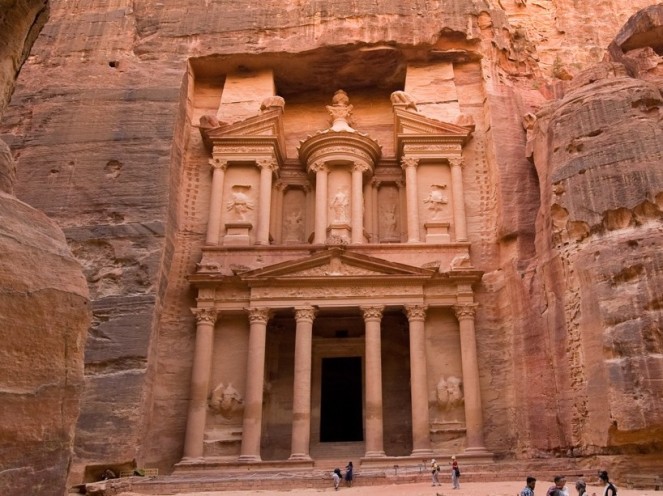
Most of the historians believe that name Petra derives from the Greek word ‘pietra’ meaning ‘stone’, a reference to the rocky landscape of the area. But we also cannot ignore the fact that the Greek ‘pietra’ is a distorted form of the Sanskrit word ‘prastar’ (प्रस्तर) meaning ‘rock’ .
As per the ‘Dead Sea Scrolls’, the original name of Petra was ‘Rekim’ or ‘Rekem’. It is interesting to note that a close Sanskrit cognate of ‘Rekim’, the Sanskrit ‘Recin’, pronounced Rechin (रेचिन्), means red-powder.
The original Aramaic texts state that the oldest known name of Petra is Rekem-Geya which is also very interesting. It translates as ‘Red-Gaya’ from Sanskrit. Gaya has been a Hindu pilgrimage site since ancient times, located in present day state of Bihar, India. Ancient texts document the fact that various Indian tribes had migrated to far off regions in West from Bihar (then called Magadh) right up to Greece had built temples en-route and given them Vedic names.
The Egyptian campaign accounts in the Bible and the Amarna Tablets refer to Petra with names such as ‘Sela’, ‘Seir’ and ‘Pel’.
‘Shila’ (शिला), a close cognate of ‘Sela’ too means ‘rock’, ‘mountain’ or ‘rocky-mountain’ in Sanskrit. Even the word ‘pal’ (पल) is linked to ‘stone’ and occurs in Sanskrit as ‘upala’ (उपल) or as ‘shonapal’ (शोणोपल) which means ‘red-stone’. Petra is a city carved in mountains and rocks, mostly red or pink in hue.
Moses who is credited with extracting water from below the red rocky arid area of Petra. As per Aramaic Texts, until then, the site of Rekem-Geya was known as ‘Kudesh’.’Ku-desh’ (कुदेश) in Sanskrit means ‘Inhospitable Land’ or”Barren Land”.
In some texts the region is also known as Barnia-Kudesh. ‘Bhurni’ (भूर्णि) in Sanskrit means ‘desert’ or ‘distant’.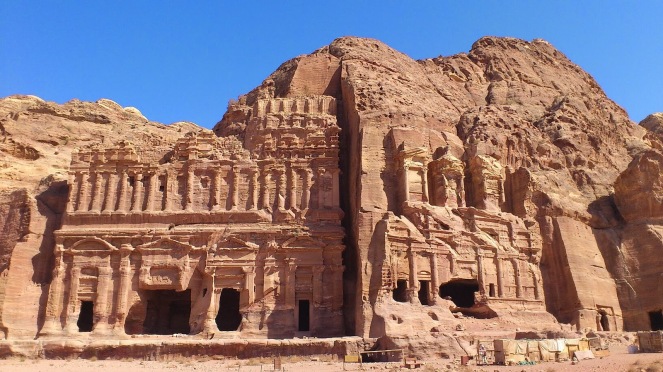 In Ramayana, we do find a mention of a multi-storied temple, built by celestial architect Vishwakarma, in a place far away from India, in the western direction.The exact location is a mystery but it is very interesting to note that the second highest mountain peak in Jordon, not very far from Petra, is known as ‘Jabal Rum/Ram’ and the region surrounding it is called ‘Wadi Rum/Ram’
In Ramayana, we do find a mention of a multi-storied temple, built by celestial architect Vishwakarma, in a place far away from India, in the western direction.The exact location is a mystery but it is very interesting to note that the second highest mountain peak in Jordon, not very far from Petra, is known as ‘Jabal Rum/Ram’ and the region surrounding it is called ‘Wadi Rum/Ram’
Now let us look at the most ancient known settlers of Petra. The tribe that settled there was known as ‘Nabha’ and in present day they are referred to as the Nabateans. In Sanskrit the word ‘Nabha’ (नभ) means the ‘Sky’. A cognate of ‘Petra’ is ‘patra’ (पतर) – [the ‘t’ here is pronounced as in ‘path’] and means ‘flying’. Finally, there is another cognate of ‘Petra’ which is the Sanskrit ‘PaTra’ (पटर) – [the ‘t’ pronounced as in the English ‘pet’], which means ‘ray of light’. The ‘sky’, ‘ray’ and ‘flying’ connection to the word ‘Nabha’ and ‘Petra’ can be attributed to Lord Vishwakarma. In Hindu mythology, Vishwakarma is the designer of all the flying chariots of the gods, and all their weapons and divine attributes. Vishwakarma is also credited with creating the missiles used in the mythological era, including the Vajra, the sacred weapon of Lord Indra.
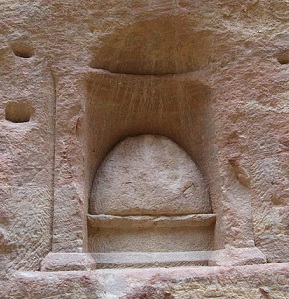
Within Petra’s largest monument, Ad Deir, there is an obelisk, representing the most important deity of the Nabateans – Dushara. Dushara was the primary male god accompanied by three female deities: Al-‘Uzzá, Allat and Manāt. The term Dushara means ‘Lord of the Shara’, which refers to the Shara mountains to the north of Petra.
The symbolic animal of Dushara was a bull. All over Petra, Dushara was represented symbolically by stone blocks called baetyl. A baetyl physically marked a deity’s presence. It could be a square or rounded like a dome. Some baetyls were depicted with a lunar crescent on the top.
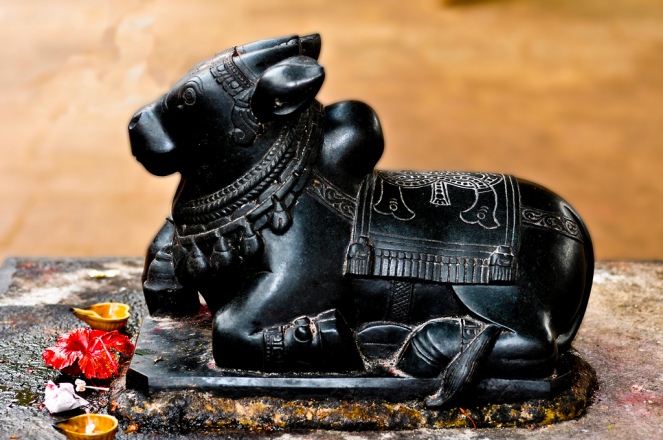 The similarities between Dushara and Shiva are hard to be ignored.
The similarities between Dushara and Shiva are hard to be ignored.
His symbolic animal is a bull, named Nandi. Shiva is also associated with the mountains; his abode is in the Kailash Mountain in the Himalayas where he spends most of his time engaged in rigorous asceticism.Shiva is worshipped all over India in the form of a black block of stone known as Shiva Linga. A Shiva Linga, which is essentially a ‘mark’ or ‘symbol’ of Shiva, much like the idol of Dushara in the temple of Al Deir.
The consort of Dushara was known to the Nabateans as Al-Uzza or Al-lat. She was a goddess of power and a goddess of the people, and was symbolized by a lion. Lions are present at many sites in Petra. The lion is also associated with the consort of Shiva, Parvati, Durga or Shakti. the victory of Durga over the forces of evil represented by Mahisasura, is one of the most widely celebrated religious festivals in India, known as Dussehra / Durga Utsab which is celebrated over a period of ten days. The cult of Shiva-Shakti represented the sacred masculine and feminine principles, and the worship of Shiva has always been inextricably linked with the celebrations of Durga. There are indications that the Nabataeans, too, may have celebrated this ancient festival at Petra due to the presence of massive, flat, courtyard, carved out of the rock, capable of accommodating thousands of people.
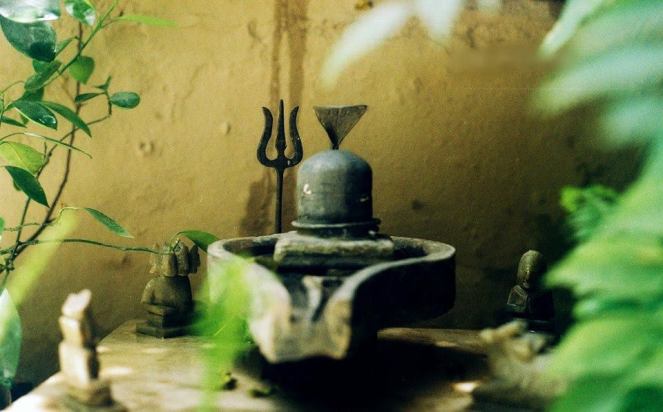 Interestingly, the Nabataeans worshipped the triad of goddesses – Al-Uzza, Al-lat and Manat – often depicted in Petra in the form of three baetyls, carved next to each other.
Interestingly, the Nabataeans worshipped the triad of goddesses – Al-Uzza, Al-lat and Manat – often depicted in Petra in the form of three baetyls, carved next to each other.
Al-Uzza (the ‘Strong One’) was the goddess of the morning and evening star. She was the virgin-warrior and the youngest in the goddess triad, fiercely protective, and a strong ally in an approaching battle. She was sometimes depicted riding a ‘dolphin’ and showing the way to sea-farers. In the Rig Veda, Usas, the goddess of dawn, who appears in the east every morning, resplendent in her golden light, riding a chariot drawn by glorious horses, dispelling the darkness, awakening men to action, and bestowing her bounty and riches on all and sundry. The phonetic and symbolic associations between ‘Uzza’ and ‘Usa’ indicate that they may be derived from the same source.
Al-lat was widely regarded as ‘the Mother of the Gods’, or ‘Greatest of All’. She was the goddess of fertility and prosperity. She was symbolically associated with vegetation, grains and prosperity, and was frequently depicted holding cereal stalks and a small lump of frankincense in her hands. In this respect, Al-lat is symbolically associated with the Hindu goddess ‘Lakshmi’, who is also considered as the goddess of prosperity and fertility, and is depicted holding cereal stalks and a container of grains.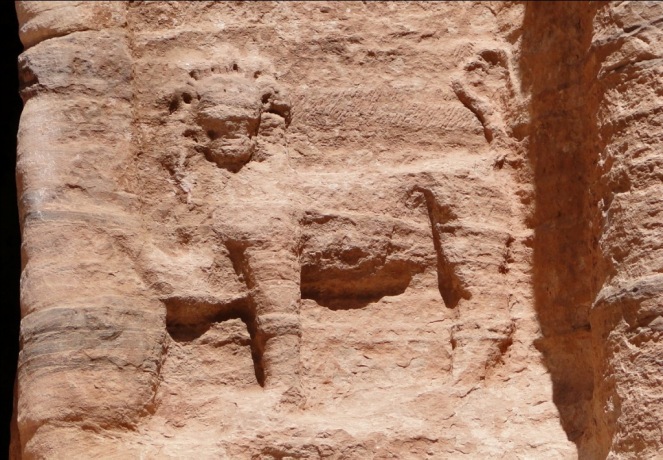 The third goddess of the Nabataean triad, Manat, is the oldest goddess of the Nabataeans, and also the most feared. She was the terrible, black goddess of death, destruction and doom, and was worshipped as a black stone at Quidaid, near Mecca. Nabataean inscriptions tell us that tombs were placed under her protection, asking her to curse violators. The symbolism of Manat bears stark resemblances to the Hindu goddess of death and destruction – Kali – who is also worshipped in the form of a black goddess.
The third goddess of the Nabataean triad, Manat, is the oldest goddess of the Nabataeans, and also the most feared. She was the terrible, black goddess of death, destruction and doom, and was worshipped as a black stone at Quidaid, near Mecca. Nabataean inscriptions tell us that tombs were placed under her protection, asking her to curse violators. The symbolism of Manat bears stark resemblances to the Hindu goddess of death and destruction – Kali – who is also worshipped in the form of a black goddess.
We can, therefore, see that the Nabataean triad of goddesses – Al-Uzza, Al-Lat and Manat – corresponds to the Vedic/Hindu goddess triad– Usa, Lakshmi and Kali. And here is the most interesting part: Even now, this goddess triad is worshipped in many parts of India, with the sole exception that Usa is often replaced by Saraswati, the goddess of learning and wisdom.
The Nabateans built a few other cities in the desert, one of which is the archaeological site of ‘Shivta’ built in the 1st century BC on the ‘Perfume Road’ between Petra to Gaza. Like Petra, Shivta too was abandoned by the 8th – 9thcentury CE, after the ascendancy of Islam. A few kilometers from Shivta is located the ancient, biblical city of ‘Tel Sheva’, an archaeological site in southern Israel, which derives its name from a nearby ‘well’ or ‘water source’. The phonetic and symbolic similarities between these cities and ‘Shiva’ are obvious. In fact, the worship of Shiva-Shakti was widespread across the entire Middle East and West Asia, and penetrated deep into the farthest corners of Europe in the centuries before Christ. The biblical kingdom of ‘Sheba’ (Hebrew: Sh’va) believed to be in present day Yemen, as well as the archaeological site of ‘Shibham’ (Sanskrit: Shivam) located in Yemen, hint at the fact that entire kingdoms and cities were named after this deity. 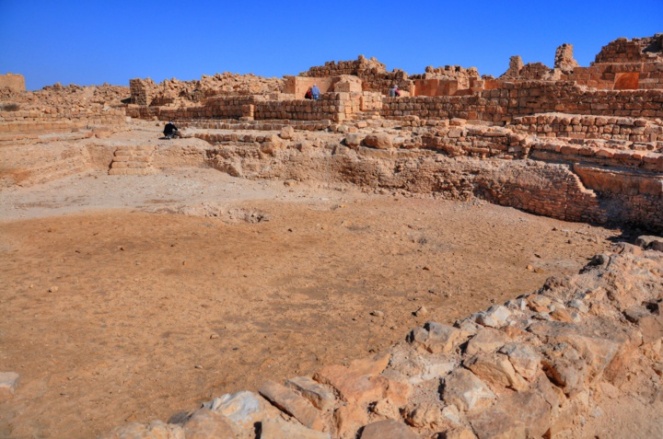
It is unfortunate that these symbolisms and associations have been either overlooked or ignored by historians till now. What is even more regrettable is the fact that the Shiva Linga, and, in fact, any Pillar or Dolmen cult, has been uniformly interpreted as a form of phallic worship, when the information from the ancient sources clearly specify that the ‘pillar’ represents the ‘Cosmic Mountain’, the symbolic axis-mundi of the cosmos, around which the heavens revolve. It is a powerful cosmic symbol, fusing the divine masculine and feminine principles, whose meaning was universally understood by the ancient cultures, but whose real import has been lost to us now. Unless we begin to acknowledge the widespread presence of the Shiva-Shakti cult in large parts of the ancient world, and make a sincere attempt to understand the vast array of symbolisms associated with this ancient faith, we will continue to concoct a version of history that is illusory, fragmentary, and ultimately meaningless.
Good article man , keep it up and write more articles about Hinduism and Vedic learnings. By the way I am going to Jordan tomorrow, so let me know if you want to take photos from specific places which will help build up a vedic link.
LikeLike